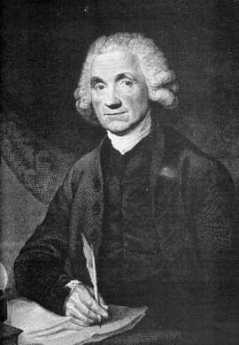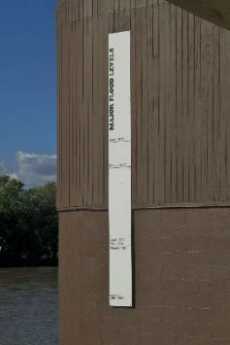Related Topics
Religious Philadelphia
William Penn wanted a colony with religious freedom. A considerable number, if not the majority, of American religious denominations were founded in this city. The main misconception about religious Philadelphia is that it is Quaker-dominated. But the broader misconception is that it is not Quaker-dominated.
Science
Science
Central Pennsylvania
"Alabama in-between," snickered James Carville, "Philadelphia, Pittsburgh, and Alabama in-between."
Joseph Priestley of Northumberland, PA

|
| Joseph Priestly |
There's one good thing about living near the confluence of two big rivers, and one very bad thing about it. The rivers provide transportation in three directions, but about once every twenty-five years the rivers rise astonishingly and threaten to carry everything away. That deposits rich topsoil, making it even more attractive for settlers to locate there. At what we now call Northumberland located on the junction of the North and West Branches of the Susquehanna, there is a monument marking off the flood levels of the past two centuries. Even the least of these floods must have covered a lot of ground, and the highest one is so far above the head of a visitor that it is hard to see how anything could have survived it. Right now, the little town of Northumberland is a burnished little jewel. One hopes the Army Corps of Engineers either has or soon will abate the potential flood danger. It would be interesting to know if flood insurance is available, just as a sign of how experts currently evaluate the risk. The Endless Mountains (that's really their name) stretching almost to Cooperstown, catch a lot of rainwater and snow and occasionally funnel it all down the North Branch to Northumberland. The West Branch is even bigger. Having observed the 1936 flood in Pittsburgh, I can testify it isn't an experience soon forgotten.

|
| Flood Levels |
It happens the most prominent resident of the area arrived there in 1794 and lived out the last ten years of his life as a widower. Joseph Priestley, an English dissenting minister had stirred up enough uproar to cause his house to be burned to the ground. No doubt, the English wanted to suppress any repetition of the French Revolution but were willing enough to be rid of a protege of Lord Shelbourne so the government made full restitution of the value of his property when he finally agreed to emigrate. Pennsylvania was chosen on the advice of his good friend Benjamin Franklin. He bought extensive land at the river junction and constructed what most people would describe as a beautiful mansion on reasonably high ground with a river entrance. Although it is built of wood and William Penn's Pennsbury was brick, there is a definite similarity. Priestley's house somehow seems more open and livable, although the outhouse reminds us that plumbing costs were moderate at the time. And furthermore, the original building survives as Pennsbury did not. The original plans for it were later discovered in England, and so it has been possible to make it what it used to be, outbuildings and all. Priestley and Lavoisier did not get along even though they share the honors for discovering Oxygen. Lavoisier was a rich aristocrat, while Priestley was a prominent member of the dissenting class with advanced ideas about democracy. It is said that many of the ideas Thomas Jefferson had about the natural rights of mankind were brought into sharper focus by his association with Priestley. Priestley was primarily a political theorist, acting in the role of a minister. He regarded his chemical experiments as a hobby, motivated by the hope of discovering a bridge between religion and science. The relationship between Priestley and Lavoisier was a strange one, but it had political conjunction as well as a scientific one. Priestley was driven to America by English Tories the same year that Lavoisier was guillotined by French revolutionaries.
Although oxygen had been discovered while Joseph Priestley was still in England, he discovered carbon monoxide in Northumberland, using retorts and scientific instruments he designed and sent to his friend Wedgwood to manufacture. He also devised the idea of carbonated water while he was here. For these as well as chemical methodologies he has been described, at least by Anglo Saxons, as the Father of Chemistry. Following what he considered to be his main occupation he meanwhile founded the Unitarian Church in America. In the little town at the Susquehanna forks, he was unable to establish a viable Unitarian congregation beyond a few followers who came to his home. So, he somehow found the energy to establish the First Unitarian Church in Philadelphia, at 21st and Walnut Streets. (Aside from its historic significance, the present church building is a distinguished work of architecture designed by Frank Furness). Meanwhile, he was very active in national politics; Jefferson's defeat of John Adams' reelection is often ascribed to his efforts.
His wife died of tuberculosis before they could move into the Northumberland plantation, but he lived there with his son and daughter-in-law for ten years, dying in 1804. The son was concerned with founding a utopian colony, but the wealthy daughter-in-law forced a return to England. The grandson generation returned to Northumberland, where the graveyard now has an impressive array of Priestley tombstones.
REFERENCES
| The Invention of Air: A Story of Science, Faith, Revolution,and The Birth of America, Steven Johnson ISBN: 978-1-59448-852-8 | Amazon |
Originally published: Tuesday, October 05, 2010; most-recently modified: Wednesday, May 22, 2019